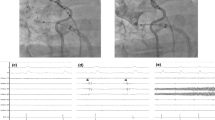Abstract
Purpose
Our aim was to analyse the temperature behaviour during second-generation cryoballoon ablation (CB-A) in patients with ongoing atrial fibrillation (AF) compared with those in sinus rhythm (SR).
Methods
Consecutive patients with drug-resistant AF who underwent pulmonary vein (PV) isolation by CB-A from April 2014 to May 2015 were analysed. The exclusion criteria were any contraindication for the procedure including the presence of an intracavitary thrombus, uncontrolled heart failure, contraindications to general anaesthesia and cardioversion to SR during the ablation procedure.
Results
A total amount of 323 consecutive patients having undergone PV isolation by means of CB-A (male 66 %, age 56.1 ± 13.4 years) was enrolled. During ablation in the left-sided PVs, time needed to reach −20°, −30° and −40° was significantly shorter in patients with AF than those in SR. During ablation in the right superior pulmonary vein (RSPV), time to reach −30° and −40° was also significantly longer in patients with AF; during ablation in the right inferior pulmonary vein (RIPV), although the temperature drop was faster in the AF group, times needed to reach −20°, −30° and −40° were not significantly prolonged compared with those in the SR group. Temperatures attained at 60 s, and minimal temperatures were also significantly lower in the AF group during all PV ablations except RIPV.
Conclusions
The temperature drop during AF cryoablation was significantly faster and attained significantly lower freezing degrees in patients with ongoing AF during the procedure compared with those in SR. This finding resulted markedly significant during each PV isolation except for RIPV cryoablation.

Similar content being viewed by others
References
Andrade JG, Khairy P, Guerra PG, Deyell MW, Rivard L, Macle L, et al. Efficacy and safety of cryoballoon ablation for atrial fibrillation: a systematic review of published studies. Heart Rhythm. 2011;8:1444–51.
Di Giovanni G, Wauters K, Chierchia GB, Sieira J, Levinstein M, Conte G, et al. One-year follow-up after single procedure cryoballoon ablation: a comparison between the first and second generation balloon. J Cardiovasc Electrophysiol. 2014;25:834–9.
Metzner A, Reissmann B, Rausch P, Mathew S, Wohlmuth P, Tilz R, et al. One-year clinical outcome after pulmonary vein isolation using the second-generation 28-mm cryoballoon. Circ Arrhythm Electrophysiol. 2014;7:288–92.
Ciconte G, Baltogiannis G, de Asmundis C, Sieira J, Conte G, Di Giovanni G, et al. Circumferential pulmonary vein isolation as index procedure for persistent atrial fibrillation: a comparison between radiofrequency catheter ablation and second-generation cryoballoon ablation. Europace. 2015;17:559–65.
Ghosh J, Sepahpour A, Chan KH, Singarayar S, McGuire MA. Immediate balloon deflation for prevention of persistent phrenic nerve palsy during pulmonary vein isolation by balloon cryoablation. Heart Rhythm. 2013;10:646–52.
Ciconte G, Mugnai G, Sieira J, Velagic V, Saitoh Y, Irfan G, et al. On the quest for the best freeze: predictors of late pulmonary vein reconnections after second-generation cryoballoon ablation. Circ Arrhythm Electrophysiol. 2015;8:1359–65.
Lustgarten DL, Keane D, Ruskin J. Cryothermal ablation: mechanism of tissue injury and current experience in the treatment of tachyarrhythmias. Prog Cardiovasc Dis. 1999;41:481–98.
Chun KR, Fürnkranz A, Schmidt B, Metzner A, Tilz R, Zerm T, et al. Right ventricular rapid pacing in catheter ablation of atrial fibrillation: a novel application for cryoballoon pulmonary vein isolation. Clin Res Cardiol. 2009;98:493–500.
Chao TH, Tsai LM, Tsai WC, Li YH, Lin LJ, Chen JH. Effect of atrial fibrillation on pulmonary venous flow patterns assessed by Doppler transesophageal echocardiography. Chest. 2000;117:1546–50.
Bollmann A. Pulmonary venous flow assessed by Doppler echocardiography in the management of atrial fibrillation. Echocardiography. 2007;24:430–5.
Tükek T, Yildiz P, Akkaya V, Karan MA, Atilgan D, Yilmaz V, et al. Assessment of left atrial appendage function and its relationship to pulmonary venous flow pattern by transesophageal echocardiography. Int J Cardiol. 2001;78:121126.
Steen T, Voss BM, Smiseth OA. Influence of heart rate and left atrial pressure on pulmonary venous flow pattern in dogs. Am J Physiol. 1994;266(6 Pt 2):H2296–302.
Furnkranz A, Bordignon S, Schmidt B, Bohmig M, Bohmer MC, Bode F, et al. Luminal esophageal temperature predicts esophageal lesions after second-generation cryoballoon pulmonary vein isolation. Heart Rhythm. 2013;10:789–93.
Fürnkranz A, Bordignon S, Böhmig M, Konstantinou A, Dugo D, Perrotta L, et al. Reduced incidence of esophageal lesions by luminal esophageal temperature-guided second-generation cryoballoon ablation. Heart Rhythm. 2015;12:268–74.
Author information
Authors and Affiliations
Corresponding author
Ethics declarations
Conflict of interest
GBC and CdA receive compensation for teaching purposes and proctoring from AF solutions, Medtronic. PB receives research grants on behalf of the centre and speaker’s fees from Medtronic. CdA is consultant for Daiichi Sankyo. GM received an educational grant from Medtronic for Postgraduate in Cardiac Electrophysiology and Pacing academic course.
Additional information
Giacomo Mugnai and Darragh Moran equally contributed as first co-authors.
Carlo de Asmundis and Gian-Battista Chierchia equally contributed as senior co-authors.
Rights and permissions
About this article
Cite this article
Mugnai, G., Moran, D., Ströker, E. et al. Cryoballoon ablation during atrial fibrillation is associated with faster temperature drop and lower freezing temperatures. J Interv Card Electrophysiol 47, 357–364 (2016). https://doi.org/10.1007/s10840-016-0175-9
Received:
Accepted:
Published:
Issue Date:
DOI: https://doi.org/10.1007/s10840-016-0175-9




